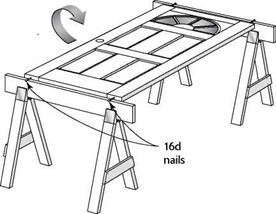Do the prep work for exterior finishes
Exterior siding and trim must be painted on all sides, not just on the surfaces that will be
exposed to the weather. Back-prime the trim before installation. On doors and windows with wood casings, make sure you back-prime all casings before installing the unit.
Take the time to fill all nail holes with exterior-grade wood putty. Don’t caulk under the lap between siding boards. Always use a good-quality, long-lasting, paintable, exterior – grade caulk. Mask and cover any decks or railings to protect them from drips and spills. Cover the foundation or walkways to keep paint from staining the concrete. Take the time to do it right. There is no excuse for being sloppy with paint. Drops of paint on a wood deck or concrete foundation will look bad for years to come.


Much can be done with exterior paint to give a house a classy style. There is an old house in our neighborhood that has just been repainted lavender with light-violet trim. Now, this may not be your choice of colors, but it brightens up our neighborhood in a nice way. I like it better than the Coos Bay gray that makes so many buildings look like army barracks. A good choice of colors can make a home warm and inviting. Some paint dealers have a computer program that shows you what different color combinations will look like on your house. Give your house a virtual paint job to test out various color schemes.
Once you have selected the color, try rolling paint on lap siding with a roller that matches the width of the laps. Once the paint has been rolled on, it must be brushed in to make sure every crack and crevice is covered properly. Take special care when painting the bottom edges of siding. These edges must be well coated because it is where moisture and ice gather.
Latex paint dries rapidly in hot weather, so don’t roll on too much paint before you go back over it with a brush. Remember, too, that most paints require a wall temperature of at least 50°F or so for good adhesion, so don’t paint if the weather is cooler than that.
Completely paint or stain the siding before you tackle the exterior trim, just as you did on the
Drive 16d nails temporarily into the top and bottom of the door. Rest the nails on sawhorses and paint one side of the door, then the other.
interior. Use a good brush and a steady hand to leave a neat-looking job. Doors get a lot of use, so it’s best to give them at least a couple of coats on top of the primer. The metal-clad exterior doors that are often used on affordable houses come with a prime coat. You may want to use a higher – gloss paint on doors because it is easy to clean.
Instead of trying to paint doors in place, take them down and remove all the hardware. Put the hardware for each door in a small plastic bag, label the bag, and store it in a kitchen drawer. Label the door, too. The top edge is a good place to write the door’s location. Drive nails or screws into the top and bottom edges, then set the door across a pair of sawhorses (see the illustration below). After painting one side, flip over the door and paint the other side. Set the door aside, resting it on the nails, while you paint another door. Wait until the first coat is dry, then apply a second coat, brushing out any streaks or drips. When you’re done, remember to put a bit of caulk in the top nail holes so water can’t enter.
Door jambs are also easier to paint when there’s no door in the way. On some exterior entries, weatherstripping is installed on the door; on others, it’s installed on the jamb. Either way, it’s usually best to remove weatherstripping before painting instead of trying to paint around it. Getting paint on weatherstripping can prevent it from sealing properly. If the weatherstripping is damaged or difficult to reinstall, just buy new material. It is generally inexpensive and is important for sealing the interior of the house from the elements.
Once you are finished painting, use a small piece of cardboard to scrape all unused paint into one can. Save some paint for later touch-up work. A contractor I know takes leftover cans of latex paint, stirs them together, and uses the mixture as back-primer for the next job. Some cities have a site where you can drop off paint for recycling. Otherwise, take unused paints, stains, and solvents to a hazardous-waste facility. Give the earth a break. Don’t dump toxic materials on the ground or down the sink.


LEARNING FROM YOUR FELLOW VOLUNTEERS
When volunteers show up to build a Habitat house, they often find themselves assigned to jobs they’ve never done before. Still, with the proper training and supervision, they’re almost always capable of rising to the challenge and making a significant and meaningful contribution to providing another family a decent home. And sometimes in the process stereotypes are broken and we learn from one another.
On the second day of a six-day blitz in 1993, during which we built 20 houses, I was roofing with Bunny Church and her friend, Stuart Phillips.
It was a hot, steamy day, and we had just half a day to start and finish shingling a roof, so we set to the task energetically and with great focus.
After a couple of hours of hard labor up on that roof, the temperature rising all the while we were working, we were tired, dirty, and thirsty. Suddenly, Stuart stopped our roofing production line, sighing, “I’m sorry, but I just have to put on some lipstick. Lipstick always makes me feel better."
She excused herself, climbed down the ladder to the ground, pulled her lipstick out of her pocket, then went to the Porta Potti. A moment later, Stuart emerged, still dirty and dusty, but also smiling and
radiant, her lips perfectly covered with pink lipstick. It did help!
Despite being something of a tomboy, I appreciated the lesson Stuart had unintentionally taught me—that it’s okay to assert your femininity on the job. And that’s one of the wonderful things about Habitat—everyone is welcome. How many roofers wear lipstick? If your heart is open, the diversity you encounter while working on a Habitat house just might enrich your life. And remember: Lipstick can make you feel better! —Anna G. Carter
llllllllllllllllllllllllllllllllllllllllllllllllllllllllllllllllllllllllllllllllllllllllllllllllllllllllllllllllllllllllllllllllllllllllllllllllllllllllllllllllllllllllllllllllllllllllllllllllllllllllllllllllllllllllllllllllllllllllllllllllllllllllllllllllllllllllllllllll
|
|







Leave a reply